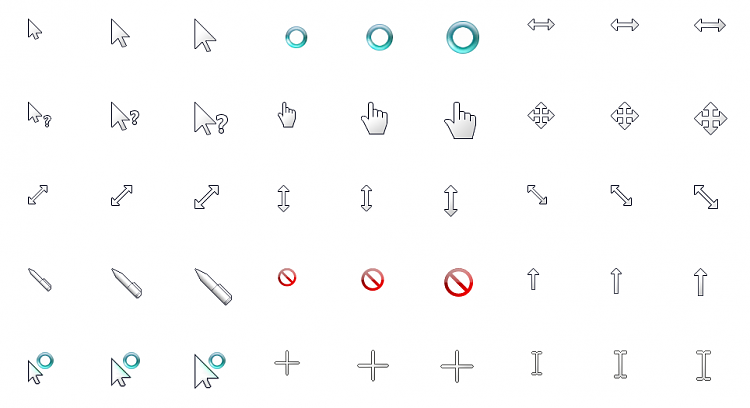We were the first cursor site to allow cursor hot linking and cursor download. There have been many imitators since but you will not see the quality and quantity like here at Cursors-4U.com.
© 2005-2021 Cursors-4U.com. All Rights Reserved. All Trademarks And Copyrights Held By Their Respective Owners.


The mouse cursors is the one and only thing that represents our hands inside our systems. Looking at the same dull mouse pointer everyday can seriously increase your boredom and undermine your productivity. Installing a new mouse cursor theme on Windows is fast, easy, and can provide just the right refreshment for your desktop. Free Cursors Windows Cursors Downloads for Windows 10, 8, 7, Vista and Windows XP browse our collection of freeware cursors to spice up your computer. We also have simple step-by-step install instructions. Simple instructions to install windows cursors into your computer for Windows 10, 8, 7, Vista and Windows XP. Download 30 best mouse cursors for Windows 1. This is our favorite set of custom mouse cursors for Windows PCs. Numix pointers are smooth. The Polar Cursor pack was inspired by a similar custom cursor theme for Linux. It features white mouse.
-->This section discusses the following topics.

- Download this app from Microsoft Store for Windows 10. See screenshots, read the latest customer reviews, and compare ratings for Mouse pointer highlight.
- Unzip the cursor file. Many cursor packs come in ZIP format (like.zip,.7s, or RAR), so you'll need to use a program like 7-Zip to unpack it. If the file is in.zip format, you can use the default Windows tool to extract the files by double-clicking it and then clicking Extract.
Creating a Cursor
The following example creates two cursor handles: one for the standard hourglass cursor and one for a custom cursor included as a resource in the application's resource-definition file.
You should implement custom cursors as resources. Rather than create the cursors at run time, use the LoadCursor, LoadCursorFromFile, or LoadImage function to avoid device dependence, to simplify localization, and to enable applications to share cursor designs.
The following example uses the CreateCursor function to create a custom cursor at run time. The example is included here to illustrate how the system interprets cursor masks.
Minitool partition wizard 7. To create the cursor, CreateCursor applies the following truth table to the AND and XOR masks.
| AND mask | XOR mask | Display |
|---|---|---|
| 0 | 0 | Black |
| 0 | 1 | White |
| 1 | 0 | Screen |
| 1 | 1 | Reverse screen |
For more information, see Bitmaps.
Driver ti cc2540 usb cdc. Before closing, you must use the DestroyCursor function to destroy any cursors you created with CreateCursor. It is not necessary to destroy cursors created by other functions.
Displaying a Cursor
The system automatically displays the class cursor (the cursor associated with the window to which the cursor is pointing). You can assign a class cursor while registering a window class. The following example illustrates this by assigning a cursor handle to the hCursor member of the WNDCLASS structure identified by the wc parameter.
When the window class is registered, the cursor identified by 230 in the application's resource-definition file is the default cursor for all windows based on the class.

Your application can change the design of the cursor by using the SetCursor function and specifying a different cursor handle. However, when the cursor moves, the system redraws the class cursor at the new location. To prevent the class cursor from being redrawn, you must process the WM_SETCURSOR message. Each time the cursor moves and mouse input is not captured, the system sends this message to the window in which the cursor is moving.
You can specify different cursors for different conditions while processing WM_SETCURSOR. For example, the following example shows how to display the cursor whenever the cursor moves over the icon of a minimized application.
When the window is not minimized, the system displays the class cursor.
You can replace a class cursor by using the SetClassLong function. This function changes the default window settings for all windows of a specified class. The following example replaces the existing class cursor with the hCurs2 cursor.
For more information, see Window Classes and Mouse Input.

Confining a Cursor
The following example confines the cursor to the application's window and then restores the cursor to its previous window. The example uses the GetClipCursor function to record the area in which the cursor can move and the ClipCursor function to confine and restore the cursor.
Because there is only one cursor at a time available in the system, an application that confines the cursor must restore the cursor before relinquishing control to another window.
Using Cursor Functions to Create a Mousetrap
The following example uses the SetCursorPos, GetCursorPos, CreateCursor, LoadCursor, and SetCursor functions to create a simple mousetrap. It also uses cursor and timer functions to monitor the cursor's position every 10 seconds. If the cursor position has not changed in the last 10 seconds and the application's main window is minimized, the application changes the cursor and moves it to the mousetrap icon.
An example for a similar mousetrap is included in Icons. It uses the LoadCursor and LoadIcon functions instead of the more device-dependent CreateCursor and CreateIcon functions.
Windows Cursors Custom
Using the Keyboard to Move the Cursor
Windows Cursors Deviantart
Because the system does not require a mouse, an application should be able to simulate mouse actions with the keyboard. The following example shows how to achieve this by using the GetCursorPos and SetCursorPos functions and by processing input from the arrow keys.